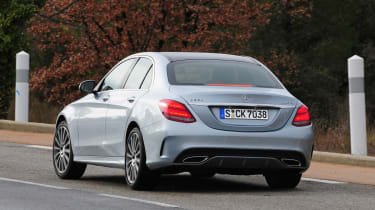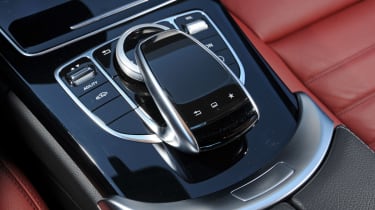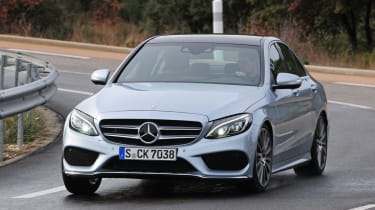Mercedes C250 BlueTEC review
We test new 2014 Mercedes C-Class C250 BlueTEC in AMG Line trim for the first time

Conservative in some respects, adventurous in others, the new Mercedes C-Class carefully refines a familiar, established formula into a potential class leader. The version that we tested isn’t perfect, but it’s definitely sharper to drive than before. More importantly, the raw ingredients show real promise – by being more practical, more efficient and offering S-Class levels of comfort, the C-Class seems to get much of the everyday stuff you take for granted absolutely spot-on. It’ll give the 3 Series a hard time when the two come face-to-face in the summer.
The outgoing Mercedes C-Class accounted for just over one in five of every new Mercedes sold across the world. That means the all-new model has some big shoes to fill, not to mention a class-leading BMW 3 Series to compete with. We hit the road to see if this poshest-ever C-Class is up to the job. Here we drive the C250 BlueTEC model - BlueTEC being the name for the diesels in the range, replacing CDI.
It’s a little bit bigger than the outgoing model, and although it borrows plenty of S-Class design features, the newcomer is still recognisably a C-Class. All UK cars get an SL-style two-bar grille, but our AMG Line test model adds a smart bodykit featuring different bumpers and bigger wheels that give the understated looks more attitude.
Used - available now

2021 Mercedes
C Class
31,655 milesAutomaticPetrol1.5L
Cash £16,987
2021 Mercedes
C Class
47,924 milesAutomaticDiesel2.0L
Cash £18,387
2019 Mercedes
C Class
29,010 milesAutomaticDiesel2.0L
Cash £18,387
2021 Mercedes
C Class
42,276 milesAutomaticPetrol1.5L
Cash £15,987Our car also boasts the optional LED headlights from the S-Class, which look pretty modern, if not quite as aggressive as the outgoing model’s. Although it’s not exactly obvious in pictures, the model’s side profile is quite different to the old version’s; the bonnet is longer, which has pushed the car’s cabin back a little, while the signature dropping crease running down the flank catches the light and makes the C-Class appear muscular and distinctive.

The C-Class’s slippery design is functional, too. Its tapered C-pillars help cut drag to 0.26 – less than that of a Toyota Prius – and noticeably reduce wind noise on the move.
While the exterior is understated, the interior is a more obvious step forward. The steering wheel and pedals are well positioned, bringing the driving position much more on a par with that of the 3 Series, while the design and trim quality make the BMW seem old-fashioned in comparison.
The dashboard is dominated by a central tablet display. A seven-inch screen is standard, but our car had the optional 8.4-inch unit. It’s really clear and easy to use. Many of the functions are familiar from the old model, but the graphics and icons have been redesigned so they’re easier to see.

As previously, you can use the infotainment unit via a rotary controller located between the front seats. However, you also get a touchpad which does a good job of recognising swiping and pinching gestures, just like a smartphone.
Our test car’s 2.1-litre diesel is carried over, albeit with tweaks to bring CO2 emissions in line with those of the BMW 320d EfficientDynamics and so improving the C250’s potential for fleet buyers. It still has decent performance, including plenty of mid-range shove once the engine has pushed through the turbo lag.
Yet even though Mercedes has added more sound deadening, the cabin is still noisy. Refinement has been stepped up in a big way, so the engine’s obvious blare is an unwelcome intrusion right across the rev range. You also notice quite a bit of vibration through the pedals.
The gearbox is carried over, too. It’s still smooth in Comfort mode, and responds quickly to manual changes if you need to drop a gear when driving down a steep hill. However, it trips up when you select Sport or Sport+, kicking down unpredictably and causing the engine to rev hard, thus increasing noise but running out of puff too quickly.
We only had the chance to test the car with the optional adaptive air-suspension. This £895 extra is currently unique in the class. Again, it’s at its best in Comfort mode, giving a slightly bouncy but very agreeable ride, even with our car’s big rims and low-profile tyres. The steering could be a little more responsive just off centre in Sport mode, to give a more agile feel, but the car does handle very precisely.
This is partly down to the new MRA architecture that debuts on this car, cutting 100kg from the previous model’s weight. It also contributes to the engine’s claimed efficiency gains.

When cornering hard, you also notice that the powerful brakes have a torque-vectoring feature, which smoothly pinches the rear brakes to help turn the nose into bends. Combined with the weight loss, it gives a sharp drive that brings the Merc closer to the 3 Series.
However, while it’s interesting to see how the C-Class feels for a keen driver, it’s more telling to find out how the car behaves when you’re not pretending to be Lewis Hamilton. On a long motorway cruise, with everything set to Comfort and the stereo turned up, the C-Class is incredibly refined. Even the engine settles down to give superb cruising ability – it just eats up motorway miles without stressing the driver in any way.
It doesn’t take long to realise the C-Class is much posher and more refined than its predecessor. Much of the tech is carried over, albeit in new-generation form, a better design or simply lifted from the S-Class. Arguably, Mercedes could’ve taken more risks, although it’s achieved a sensible balance in improving the car without jeopardising its top-selling status.
It’s a shame the powertrain isn’t quite up to scratch, but there are plenty of other models to try – ones that are more realistically specced than our fully loaded test car. Despite that, our first meeting with the C-Class proved it has many of the ingredients needed to give the 3 Series plenty to worry about.





